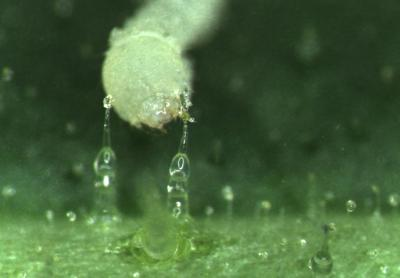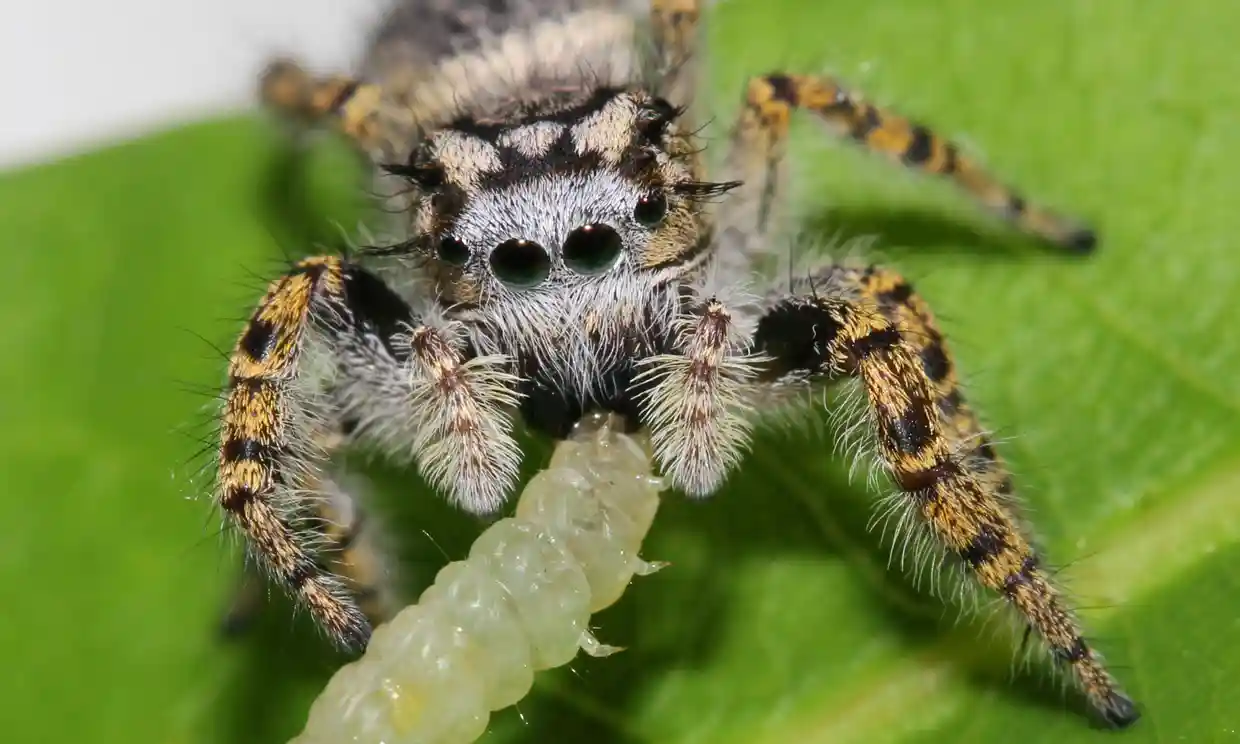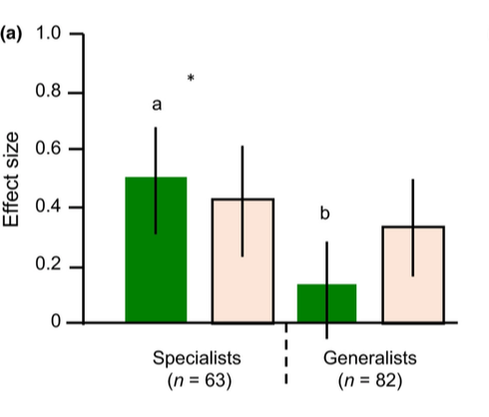[Seminar Blog] I declare a plant-insect war: The arms-race and profiteering of species interactions.12/16/2021
We may think of herbivores, or animals that feed on plants, as large lumbering creatures grazing on grass, but most of them are, in fact, insects (Forister et al., 2015). Herbivorous insects interact with the predators that seek to eat them and the plants they rely on for food. But from a plant’s perspective, the insect herbivores are the predators. Plants rely on various tools to reduce the onslaught of attack from these foliage feeders. For example, they can utilize sticky appendages called trichomes, and deploy stinky or toxic chemicals. These interactions that originate from the plant and have impacts on herbivores are known as ‘bottom-up effects’ (Figure 1). Due to the abundance of insect herbivores in nature, they are also important food sources for insect predators and parasitoids. These interactions, which involve herbivore predators, are an example of ‘top-down effects’ (Figure 1). Dr. Mayra Vidal is fascinated by the ecology and evolution of these species interactions. Now an Assistant Professor at UMass Boston, Dr. Vidal is excited to answer fundamental questions about how species interact. In her seminar for the UMD Entomology department, she focused on her work about two plant-insect interactions: herbivory, and mutualisms. Herbivory is the process in which insects feed on plants, while mutualism describes a beneficial relationship between two species. In her talk, she posed a series of questions. Why are there so many herbivores that eat only one type of plant? Can interactions between plants, herbivores, and natural enemies influence the evolution of herbivores? Can sneaky insects exploit the mutualistic relationships plants have with natural enemies? Herbivory Ninety percent of plant-eating insects only feed on certain plant groups (Forister et al. 2015). These picky eaters are known as specialists. The remainder of herbivores can feed on a wide variety of plant groups and are referred to as generalists. A portion of Dr. Vidal’s work asks why there are so many specialists and so few generalists. One theory was that most herbivores are specialists in order to adapt to overcome plant defenses. Another theory was that predation by natural enemies, top-down effects, could play a more prominent role in dietary specialization. To investigate the potential differing role of bottom-up and top-down effects on the fitness of generalists and specialists, she conducted a meta-analysis (Vidal & Murphy, 2018a). A meta-analysis is a method used to synthesize results from previous studies to examine broader patterns that may be too difficult to answer using only a single study. By looking at how fitness was affected by bottom-up effects and top-down effects as shown on the y axis (Figure 2), Dr. Vidal learned that, across studies examining leaf-chewing herbivores, bottom-up effects had greater fitness impacts, such as increased larval survival and growth rates, on specialists rather than generalists (Figure 2). She followed up this study by modeling generalist and specialist populations of fall webworm (Hyphantria cunea) across Colorado. She concluded that there is a positive relationship between the frequency of using both better quality host plants for feeding and host plants where they escaped more natural enemies, with insect fitness Vidal & Murphy, 2018b). In other words, being a generalist has certain advantages over being a specialist because they can get their food from more than one type of plant, leading to a stronger ability to compete for a wider range of resources and survive. Still, the question remains as to why there are so many more specialists than generalists? Dr. Vidal thinks the answer may lie in uncovering some of the genetic mechanisms that could be driving specialization. Using genetic analysis, she deduced that host plant use had a greater effect on the genetic divergence of specialist populations of fall webworm than generalist populations. These results are an encouraging sign in affirming her prediction that specialists are more impacted by bottom-up factors than they are by top-down factors such as natural enemies. This could help explain why there are more specialists despite the advantages of being a generalist because it indicates that specialists are under stronger selection pressure from host plants and possibly diverge into new species more quickly than generalists (Vidal et al. 2019). Mutualisms Sometimes plants form mutualistic relationships with other insects to deter herbivores. Plant-ant mutualisms can be facilitated by extrafloral nectaries, non-flowering places on plants that generate nectar. Territorial ants are attracted to the sweet nectar and will defend the plant, attacking any herbivore that gets in their way. Qualea grandiflora, a tree with yellow flowers from the Brazilian savanna, has extrafloral nectaries that can be involved in ant mutualisms. When Dr. Vidal was working on her master’s thesis in Brazil, she noticed something interesting. Some of the Q. grandiflora nectaries were blocked by brown structures. On further examination, she realized these brown structures were the larval cases of a fruit fly, Rhinoleucophenga myrmecophaga. The adult fruit fly lays its eggs next to the nectary. When the larvae hatch, they use the nectar to form their gooey shelter. When ants try to visit the nectary they get trapped in the goo and the larvae feed on them. You can watch this interaction here! Dr. Vidal was interested in discovering if the fruit fly’s use of the extrafloral nectaries would impact the mutualism with caterpillar-killing ants and, thus, increase the herbivory on the plant. She found that branches with fly larvae had significantly fewer ants and that branches with fly larvae had significantly more leaf chewing insects (Figure 4). Finally, she measured the amount of herbivory damage, or leaf holes, and found that branches with fly larvae had significantly more herbivory damage (Figure 4). She concluded that the fruit fly larvae were discouraging ants from foraging and leading to more damage by herbivores. One question still on Dr. Vidal’s mind is how plant-ant mutualisms can persist if exploitative species – in this case the fly-- keep taking advantage of them. Why should the plant continue spending resources on nectar if it is not helping them avoid being eaten? One possibility is that other ant species, less susceptible to the fly traps, may also act as mutualistic partners for the plant. This species redundancy, with multiple ant species potentially reducing herbivory on the tree, could maintain the mutualism. Dr. Vidal is broadly interested in how species interactions like herbivory and mutualisms lead to the diversification of different species. Her new lab is now starting to expand on these questions. She is continuing her mutualism work using yeasts grown in a lab to test how exploitative “cheaters” could affect the persistence of mutualisms. Dr. Vidal is also aiming to explore how the positive relationship between fitness and diet breadth could be maintained over time, especially under a changing climate. She hopes for similar research to be carried out for a larger diversity of insect groups to gain a more complete picture of how ubiquitous patterns of dietary specialization are in nature. If you are interested in this work, she is currently recruiting graduate students to work in these areas!
Authors Max Ferlauto is a 3rd year PhD student in Karin Burghardt’s lab studying the effects of suburban leaf litter management on overwintering ecology. Brendan Randall is a 1st year Master’s student in Karin Burghardt’s lab studying bottom-up effects of rhizobial diversity on plant-insect interactions and insect community structure. Sources Forister ML, et al. The global distribution of diet breadth in insect herbivores. Proc Natl Acad Sci USA. 2015; 112:442–447. Vidal, M.C., Sendoya, S.F. and P.S. Oliveira. 2016. Mutualism exploitation: Predatory drosophilid larvae sugar-trap ants and jeopardize facultative ant-plant mutualism. Ecology 97: 1650-1657. Vidal, M.C. & Murphy, S.M. (2018a) Bottom-up vs. top-down effects on terrestrial insect herbivores: a meta-analysis. Ecology Letters, 21, 138– 150. Vidal, M. C., & Murphy, S. M. (2018b). Quantitative measure of fitness in tri-trophic interactions and its influence on diet breadth of insect herbivores. Ecology, 99(12), 2681–2691. Vidal, M.C., Quinn, T.W., Stireman, J.O., Tinghitella, R.M. & Murphy, S.M. (2019) Geography is more important than host plant use on the genetic divergence of a generalist insect herbivore. Molecular Ecology, 28, 4317– 4334. Comments are closed.
|
Categories
All
Archives
June 2024
|
Department of Entomology
University of Maryland
4112 Plant Sciences Building
College Park, MD 20742-4454
USA
Telephone: 301.405.3911
Fax: 301.314.9290
University of Maryland
4112 Plant Sciences Building
College Park, MD 20742-4454
USA
Telephone: 301.405.3911
Fax: 301.314.9290






 RSS Feed
RSS Feed




